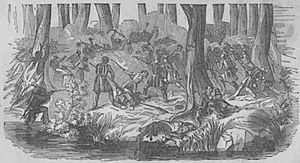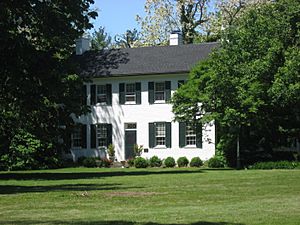William Ward (frontiersman) facts for kids
Quick facts for kids
William Ward
|
|
|---|---|
| Born | December 14, 1752 |
| Died | December 24, 1822 (aged 70) |
| Resting place | Oak Dale Cemetery, Urbana, Ohio |
| Nationality | American |
| Occupation | frontiersman, soldier, state militia officer, politician, surveyor, merchant, land speculator |
| Relatives |
|
William Ward was an important American pioneer, soldier, and town founder. He was born on December 14, 1752, and passed away on December 24, 1822. He is best known for founding the city of Urbana, Ohio. He was also one of the first settlers in Mason County, Kentucky and the Mad River Valley in Ohio.
Contents
William Ward's Early Life
William Ward was born in Augusta County, Virginia, on December 14, 1752. He was the first son of James and Phoebe Ward, who were immigrants from Ireland. His father, Captain James Ward, came to America from County Donegal, Ireland, as a baby around 1730.
William lived on the edge of the American frontier his whole life. When he was very young, his family moved to what is now Greenbrier County, West Virginia. However, this area became dangerous during the French and Indian War. So, his father moved the family closer to Staunton, Virginia.
A Lost Brother
In 1758, when William was six, he went with his father to their family mill. It was near Fort Dinwiddie on the Jackson River. They didn't know that William's three-year-old brother, John, had followed them.
Two Shawnee people were watching from the woods. They took John. Even though the family tried to track them in the snow, they couldn't find John. Years later, they learned that John was raised by the Shawnee. He was known as White Wolf.
Soldier in the Revolutionary War

In 1774, Virginia's governor, Lord Dunmore, asked for volunteers. He wanted to form a militia to fight against Native American nations along the Ohio River. William Ward joined his father's company from Botetourt County. He served as a sergeant under Colonel William Fleming.
William and his father fought in the Battle of Point Pleasant on October 10, 1774. Sadly, William's father, Captain James Ward, was killed in this battle. William then took command of the company. Later, the family found out that John Ward, their long-lost brother, also fought in this battle with his adopted Shawnee family.
By 1777, William was promoted to lieutenant. He served at Fort Randolph and in the Greenbrier area. In 1781, Captain William Ward led the militia for the Howard's/Anthony Creek area of Greenbrier.
Settling New Lands
After the Revolutionary War, William Ward married Rebecca Anderson in Greenbrier. In 1782, he helped plan and organize a new town called Camp Union. This town later became Lewisburg, West Virginia.
Between 1784 and 1786, William explored areas in what is now Kentucky. He claimed large amounts of land and used military land grants.
Ward and his family settled in Washington, near the river city of Limestone (now Maysville). This area was in Mason County, Kentucky. He became business partners with the famous frontiersman, Simon Kenton. Ward managed Kenton's store. William's two younger brothers, James and Charles, also settled in this area.
In the early 1790s, Ward became an important person in Mason County. He represented the county in the Kentucky Legislature from 1792 to 1795.
Friends with Simon Kenton
Simon Kenton and William Ward were very different people. Kenton was a tough frontiersman who couldn't read or write. He had lived in the wilderness since he was 16. William Ward, on the other hand, was a "Virginia gentleman." He was well-educated, spoke well, and had a great sense for business. Despite their differences, Kenton and Ward worked together for over 30 years.
Their paths first crossed in 1774 during Lord Dunmore's War. They were likely both at the signing of the Treaty of Camp Charlotte.
In 1788, Ward, along with Simon Kenton and Robert Rennick, tried to buy large areas of land. These lands are now where Springfield and Urbana are located. However, it was later found that the seller, John Cleves Symmes, didn't have the legal right to sell that land.
Kenton and Ward began exploring the Mad River Valley in Ohio as early as 1788. Kenton had seen the area before when he was a prisoner with the Shawnees. Ward wanted to explore the area to look for signs of his brother John.
Sadly, in April 1793, William's brother, John (White Wolf), was killed. He was killed by a militia group led by Kenton and William's other brother, Captain James Ward.
Keeping the Peace
In April 1799, Kenton and Ward led a group of families from Mason County, Kentucky to the Mad River Valley. When they arrived, Kenton and Ward worked together to prevent conflicts. The Treaty of Greenville, which ended the Northwest Indian War in Ohio, was close to breaking down.
Ward read in a newspaper that a group of Native Americans might break the treaty. Kenton and Ward immediately traveled to Detroit. They got a letter from the leader, Black Snake, saying they would not break the treaty. Ward wrote a letter, signed by both him and Kenton, which helped calm the situation.
Years later, in 1806, the Shawnee chief, Tecumseh, gathered 700 warriors. Kenton, Ward, and Colonel James McPherson rode out to meet Tecumseh. Kenton spoke for the group. He tactfully said, "we have plenty of men to greet you." After their meeting, Tecumseh decided not to start a war.
By 1810, the land partnership of Ward, Kenton, and Rennick owned over 25,000 acres near Springfield.
Founding Urbana, Ohio
In 1805, Colonel Ward went to the General Assembly in Chillicothe. He successfully argued for a new county to be created from parts of Greene and Franklin Counties. This new county, Champaign County, was formed on February 20, 1805.
Colonel Ward was smart about business. He bought 160 acres of land that he thought would be perfect for the new county's main town. He suggested to the county leaders that the town be built there. Ward offered to divide the land into lots. Half of these lots would go to the county, and he would keep the other half. He also offered land for a cemetery and a public square. The county leaders agreed. Ward named the new county seat Urbana.

In 1810, Ward served on the first board of trustees for Miami University in Oxford, Ohio. In 1814, he helped start Champaign County's first bank and a mill for grinding grain.
William Ward was a tall and important man in Champaign County. One person who knew him described him as "tall and broad-shouldered, with high cheek bones, keen eyes and dark auburn hair tied with a black ribbon in a long queue, erect in person and very neat in dress." He always wore a black felt hat with a high crown and a wide brim. He also wore a black coat and green leggings when riding his horse.
William Ward's Family and Death
Colonel Ward had seven children with his first wife, Rebecca Anderson, who passed away in 1805. He later had four more children with his second wife, Margaret Barr.
His grandsons include the famous sculptor, John Quincy Adams Ward, and the painter, Edgar Melville Ward. William's younger brother, Captain James Ward, stayed near Maysville, Kentucky. He was one of the people who helped carry the coffin when Daniel Boone was re-buried in 1845.
William Ward died on Christmas Eve, December 24, 1822. He was first buried on his family's land north of Springfield. Later, he was re-buried at the Oak Dale Cemetery in Urbana.


